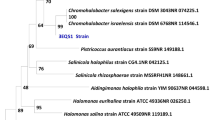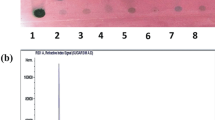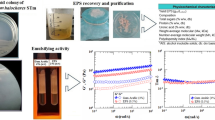Abstract
A novel exopolysaccharide (EPS) was produced by a bacterium which was isolated from Psophocarpus tetragonolobus (L) D.C. and identified as 99% Rhizobium tropici SRA1 by 16S rDNA sequencing. The flocculating performances along with emulsifying activity began simultaneously with the growth and the production of EPS and reached its utmost at 28 h. EPS was purified via chilled ethanol precipitation followed by dialysis and lyophilization. The existence of hydroxyl, methoxyl, and carboxylic functional groups were confirmed by Fourier transform infrared (FT-IR) spectrum. EPS was found to be compose of 82.44% neutral sugar and 15.93% uronic acid. The average molecular weight of the exopolysaccharide was estimated as ~ 1.8 × 105. Gas–liquid chromatography indicated the presence of glucose and galactose at a molar ratio of 3:1 in EPS. In the pH range of 3–5 with EPS dosage of 15 mg/l at 30 °C, cation-independent flocculation greater than 90% was observed. Emulsification indices (E24) of EPS were observed as 86.66%, 83.33%, 76.66%, and 73.33% with olive oil, kerosene, toluene, and n-hexane respectively. Biosorption of Cu K [45.69 wt%], Cu L [05.67 wt%], Co K [15.58 wt%], and Co L [11.72 wt%] by EPS was confirmed by energy-dispersive X-ray spectroscopy (EDS). This report on the flocculating, emulsifying, and metal sorption properties of EPS produced by R. tropici SRA1 is unique in the literature.




Similar content being viewed by others
References
Amemura A, Harada T, Abe M, Higashi S (1983) Structural studies of the acidic polysaccharide from Rhizobium trifolii 4S. Carbohydr Res. 115:165–174. https://doi.org/10.1016/0008-6215(83)88144-0.
Bhattacharyya RN (2006) Effects of heavy metals on growth and indole acetic acid production by Rhizobium sp. Bangladesh J Bot 35(1):63–69
Bhattacharyya R, Das S, Bhattacharya R, Chatterjee M, Dey A (2017) Rhizobial exopolysaccharides: a novel biopolymer for legume-rhizobia symbiosis and environmental monitoring. In: Microbes for legume improvement. Springer, Cham. pp 119–133
Bomfeti CA, Florentino LA, Guimarães AP, Cardoso PG, Guerreiro MC, Moreira FMDS (2011) Exopolysaccharides produced by the symbiotic nitrogen-fixing bacteria of leguminosae. Rev Bras Ciênc Solo 35(3):657–671. https://doi.org/10.1590/S010006832011000300001
Bramhachari PV, Dubey SK (2006) Isolation and characterization of exopolysaccharide produced by Vibrio harveyi strain VB23. Lett Appl Microbiol 43(5):571–577. https://doi.org/10.1111/j.1472-765X.2006.01967.x
Castellane TCL, Campanharoa JC, Colnago LA, Coutinho ID, Lopes ÉM, Lemos MVF, de Macedo Lemos EG (2017) Characterization of new exopolysaccharide production by Rhizobium tropici during growth on hydrocarbon substrate. Int J Biol Macromol 96:361–369. https://doi.org/10.1016/j.ijbiomac.2016.11.123
Castellane TCL, Lemos MVF, de Macedo Lemos EG (2014) Evaluation of the biotechnological potential of Rhizobium tropici strains for exopolysaccharide production. Carbohydr Polym 11:191–197. https://doi.org/10.1016/j.carbpol.2014.04.066
Castellane TCL, Persona MR, Campanharo JC, de Macedo Lemos EG (2015) Production of exopolysaccharide from rhizobia with potential biotechnological and bioremediation applications. Int J Biol Macromol 74:515–522. https://doi.org/10.1016/j.ijbiomac.2015.01.007
Chaudri AM, Allain CM, Barbosa-Jefferson VL, Nicholson FA, Chambers BJ, McGrath SP (2000) A study of the impacts of Zn and Cu on two rhizobial species in soils of a long-term field experiment. Plant Soil 221(2):167–179. https://doi.org/10.1023/A:1004735705492
Conn HJ, (1957) Staining methods. In: Society of American Bacteriologists Committee on Bacteriological Technic (Eds.), Manual of microbiological methods. McGraw-Hill Book, New York, pp 16
Decho AW (1990) Microbial exopolymer secretions in ocean environments: their role (s) in food webs and marine processes. Oceanogr Mar Biol Annu Rev 28(7):73–153
Donot F, Fontana A, Baccou JC, Schorr-Galindo S (2012) Microbial exopolysaccharides: main examples of synthesis, excretion, genetics and extraction. Carbohydr Polym 87(2):951–962. https://doi.org/10.1016/j.carbpol.2011.08.083
Dresler-Nurmi A, Fewer DP, Räsänen LA, Lindström K (2009) The diversity and evolution of rhizobia. In: Pawlowski K (ed) Prokaryotic Symbionts in Plants, Microbiol Monogr Springer Berlin Heidelberg, 8: 3–41. https://doi.org/10.1007/7171_2007_099
Dubois M, Gilles KA, Hamilton JK, Rebers PT, Smith F (1956) Colorimetric method for determination of sugars and related substances. Anal Chem 28(3):350–356. https://doi.org/10.1021/ac60111a017
Eissa AR, Abd-El-Bary ME, Fahmi AI, Nagaty HH Hassan MM (2009) Evaluation and characterization of γ induced mutants of Rhizobium leguminosarum in Vicia faba. Proceedings of the 1st Nile Delta Conference, (NDC'09), Minufiya University, Egypt 157–170.
Freitas F, Alves VD, Reis MA (2011) Advances in bacterial exopolysaccharides: from production to biotechnological applications. Trends Biotechnol 29(8):388–398. https://doi.org/10.1016/j.tibtech.2011.03.008
Ghosh PK, Ganguly J, Maji P, Maiti TK (2015) Production and composition of extracellular polysaccharide synthesized by Rhizobium undicola isolated from aquatic legume, Neptunia oleracea Lour. Proceedings National Academy Sci, India Section B: Biological Sci 85:581–590. https://doi.org/10.1007/s40011-014-0368-x
Han PP, Sun Y, Wu XY, Yuan YJ, Dai YJ, Jia SR (2014) Emulsifying, flocculating, and physicochemical properties of exopolysaccharide produced by cyanobacterium Nostoc flagelliforme. Appl Biochem Biotechnol 172(1):36–49. https://doi.org/10.1007/s12010-013-0505-7
Hoagland KD, Rosowski JR, Gretz MR, Roemer SC (1993) Diatom extracellular polymeric substances: function, fine structure, chemistry, and physiology. J Phycol 29(5):537–566. https://doi.org/10.1111/j.0022-3646.1993.00537.x
Hoang HH, Becker A, González JE (2004) The LuxR homolog ExpR, in combination with the sin quorum sensing system, plays a central role in Sinorhizobium meliloti gene expression. J Bacteriol 186(16):5460-5472. https://doi.org/10.1128/JB.186.16.5460-5472.2004
Huang KH, Chen BY, Shen FT, Young CC (2012) Optimization of exopolysaccharide production and diesel oil emulsifying properties in root nodulating bacteria. World J Microbiol Biotechnol 28(4):1367–1373. https://doi.org/10.1007/s11274-011-0936-7
Ibekwe AM, Angle JS, Chaney RL, van Berkum P (1996) Zinc and cadmium toxicity to alfalfa and its microsymbiont. J Environ Qual 25(5):1032–1040. https://doi.org/10.2134/jeq1996.00472425002500050015x
Ivashina T, Ksenzenko VN (2012) Exopolysaccharide biosynthesis in Rhizobium leguminosarum: from genes to functions. In Complex World Polysaccharides:99–127. https://doi.org/10.5772/51202
Jordan, D. C. 1984. Family 111. Rhizobiaceae Conn 1938, 321AL, In: N. R. Krieg and J. G. Holt (ed.), Bergey’s manual of systematic bacteriology, vol. 1. The Williams & Wilkins Co., Baltimore/ London. pp 236–254
Kaci Y, Heyraud A, Barakat M, Heulin T (2005) Isolation and identification of an EPS producing Rhizobium strain from arid soil (Algeria): characterization of its EPS and the effect of inoculation on wheat rhizosphere soil structure. Res Microbiol 156(4):522–531. https://doi.org/10.1016/j.resmic.2005.01.012
Mandal AK, Yadav KK, Sen IK, Kumar A, Chakraborti S, Islam SS, Chakraborty R (2013) Partial characterization and flocculating behavior of an exopolysaccharide produced in nutrient-poor medium by a facultative oligotroph Klebsiella sp. PB12. J Biosci Bioeng 115(1):76–81. https://doi.org/10.1016/j.jbiosc.2012.08.006
Mandal SM, Ray B, Dey S, Pati BR (2007) Production and composition of extracellular polysaccharide synthesized by a Rhizobium isolate of Vigna mungo (L) Hepper. Biotechnol Lett 29:1271–1275. https://doi.org/10.1007/s10529-007-9388-4
Mukherjee S, Ghosh S, Sadhu S, Ghosh P, Maiti TK (2011) Extracellular polysaccharide production by a Rhizobium sp. isolated from legume herb Crotalaria saltiana Andr. Indian J Biotechnol 10:340–345
Mousavi SA, Österman J, Wahlberg N, Nesme X, Lavire C, Vial L, Paulin L, De Lajudie P, Lindström K (2014) Phylogeny of the Rhizobium–Allorhizobium–Agrobacterium clade supports the delineation of Neorhizobium gen. nov. Syst Appl Microbiol 37(3):208–215. https://doi.org/10.1016/j.syapm.2013.12.007
Okaiyeto K, Nwodo UU, Mabinya LV, Okoh AI (2013) Characterization of a bioflocculant produced by a consortium of Halomonas sp. Okoh and Micrococcus sp. Leo. Int J Environ Res Public Health 10(10):5097–5110. https://doi.org/10.3390/ijerph10105097
Paudyal SP, Aryal RR, Chauhan SVS, Maheshwari DK (2007) Effect of heavy metals on growth of Rhizobium strains and symbiotic efficiency of two species of tropical legumes. Sci World 5(5):27–32. https://doi.org/10.3126/sw.v5i5.2652
Prajapati VD, Jani GK, Zala BS, Khutliwala TA (2013) An insight into the emerging exopolysaccharide gellan gum as a novel polymer. Carbohydr Polym 93(2):670–678. https://doi.org/10.1016/j.carbpol.2013.01.030
Roberts IS (1995) Bacterial polysaccharides in sickness and in health. Microbiology 141(9):2023–2031. https://doi.org/10.1099/13500872-141-9-2023
Sathiyanarayanan G, Bhatia SK, Kim HJ, Kim JH, Jeon JM, Kim YG, Park SH, Lee SH, Lee YK, Yang YH (2016) Metal removal and reduction potential of an exopolysaccharide produced by Arctic psychrotrophic bacterium Pseudomonas sp. PAMC 28620. RSC Adv 6(99):96870–96881. https://doi.org/10.1039/C6RA17450G
Sathiyanarayanan G, Yi DH, Bhatia SK, Kim JH, Seo HM, Kim YG, Park SH, Jeong D, Jung S, Jung JY, Lee YK (2015) Exopolysaccharide from psychrotrophic Arctic glacier soil bacterium Flavobacterium sp. ASB 3-3 and its potential applications. RSC Adv 5(103):84492–84502. https://doi.org/10.1039/C5RA14978A
Sardari RR, Kulcinskaja E, Ron EY, Björnsdóttir S, Friðjónsson ÓH, Hreggviðsson GÓ, Karlsson EN (2017) Evaluation of the production of exopolysaccharides by two strains of the thermophilic bacterium Rhodothermus marinus. Carbohydr Polym 156:1–8. https://doi.org/10.1016/j.carbpol.2016.08.062
Sivakumar T, Narayani SS, Shankar T, Dhinakaran DI (2012) Applications of exopolysaccharide producing bacterium Frateuria aurentia. Asian Pac J Trop Biomed 1:1–7
Sharma M, Dhingra HK (2013) Exopolysaccharide Cepacia: structure, biosynthesis and role in resistance to stress condition role in resistance to stress condition. Aust J Biol Sci 1(2):99–107
Skerman VBD (1959) A guide to the identification of the genera of bacteria. The Williams and Wilkins Co., Baltimore, p 210
Sutherland IW (1996) Extracellular polysaccharides. . In HJ Rehm, G. Reed, A. Pu¨hler, P. Stadler (ed.), Biotechnology–VI. VCH, Weinheim, Germany 6:615–657
Sutherland IW (1998) Novel and established applications of microbial polysaccharides. Trends Biotechnol 16:41–46. https://doi.org/10.1016/S0167-7799(97)01139-6
Tamura K, Dudley J, Nei M, Kumar S (2007) MEGA4: Molecular Evolutionary Genetics Analysis (MEGA) software version 4.0. Mol Biol Evol 24:1596–1599. https://doi.org/10.1093/molbev/msm092
Tapia JM, Muñoz JA, González F, Blázquez ML, Ballester A (2011) Mechanism of adsorption of ferric iron by extracellular polymeric substances (EPS) from a bacterium Acidiphilium sp. Water Sci Technol 64:1716–1722. https://doi.org/10.2166/wst.2011.649
Thompson JD, Higgins DG, Gibson TJ (1994) CLUSTAL W: improving the sensitivity of progressive multiple sequence alignment through sequence weighting, position-specific gap penalties and weight matrix choice. Nucleic Acids Res 22:4673–4680. https://doi.org/10.1093/nar/22.22.4673
Wei W, Wang Q, Li A, Yang J, Ma F, Pi S, Wu D (2016) Biosorption of Pb (II) from aqueous solution by extracellular polymeric substances extracted from Klebsiella sp. J1: adsorption behavior and mechanism assessment. Sci Rep 6:31575. https://doi.org/10.1038/srep31575
Yadav KK, Mandal AK, Sen IK, Chakraborti S, Islam SS, Chakraborty R (2012) Flocculating property of extracellular polymeric substances produced by a biofilm-forming bacterium Acinetobacter junii BB1A. Appl Biochem Biotechnol 168(6):1621–1634. https://doi.org/10.1007/s12010-012-9883-5
Zhou R, Wu Z, Chen C, Han J, Ai L, Guo B (2014) Exopolysaccharides produced by Rhizobium radiobacter S10 in whey and their rheological properties. Food Hydrocoll 36:362–368. https://doi.org/10.1016/j.foodhyd.2013.08.016
Acknowledgements
The authors are thankful to Anupam Roy, Indian Institute of Technology, Kharagpur, for conducting SEM-EDS study.
Funding
SD was provided with independent RGNF (RGNF-2015-17-SC-WES-22946) from UGC, New Delhi, India.
Author information
Authors and Affiliations
Corresponding author
Ethics declarations
This article does not contain any studies with human participants or animals performed by any of the authors.
Conflict of interest
The authors declare that they have no competing interests.
Electronic supplementary material

Supplementary Fig. 1
A) Isolation of microsymbionts from the root nodule of Psophocarpus tetragonolobus (L.) D.C.in Congo red containing YEMA plates. B) Scanning Electron Microscopy image of R. tropici strain SRA1 (PNG 2135 kb)

Supplementary Fig. 2
16S rRNA gene sequence based neighbor-joining tree, showing the position of Rhizobium tropici SRA1 (blue color) among the members of genus Rhizobium. Bootstrap percentages are given at the branching nodes. Bartonella japonica Fuji 18-1T (NR112790) was used as outgroup. Bar 0.01 changes per nucleotide position (PNG 838 kb)

Supplementary Fig. 3
A) Flow diagram showing the steps involved in purification of EPS from R. tropici SRA1. B) Gel permeation chromatography of crude EPS using Sepharose-6B column (PNG 884 kb)

Supplementary Fig. 4
A) Effect of different CaCl2 concentration on flocculating rate. B) Flocculating rate of EPS in different pH values in the presence and absence of CaCl2. C) Effect of temperature on flocculating rate (PNG 930 kb)
Rights and permissions
About this article
Cite this article
Das, S., Sen, I.K., Kati, A. et al. Flocculating, emulsification and metal sorption properties of a partial characterized novel exopolysaccharide produced by Rhizobium tropici SRA1 isolated from Psophocarpus tetragonolobus (L) D.C.. Int Microbiol 22, 91–101 (2019). https://doi.org/10.1007/s10123-018-0031-0
Received:
Revised:
Accepted:
Published:
Issue Date:
DOI: https://doi.org/10.1007/s10123-018-0031-0




